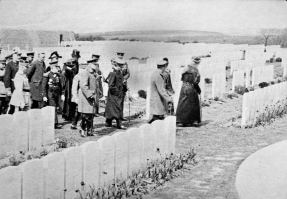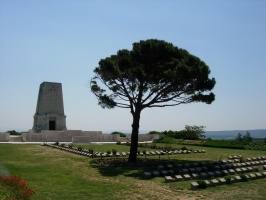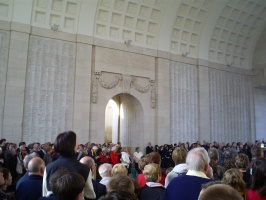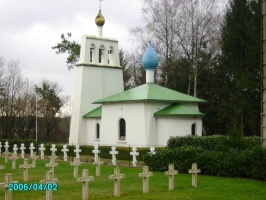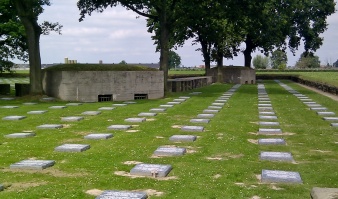Introduction↑
Succinctly defined, battlefield tourism is a type of travel that involves visiting former war zones. Beyond visiting the battlefields themselves, this type of tourism can include visits to war museums, memorials, remembrance trails, military cemeteries and hospitals, former billeting areas, as well as attending commemorations. Since the 19th century, more and more wars and conflicts have been the object of mass and enduring battlefield tourism, a branch of dark tourism.[1]
World War I (WWI) battlefield tourism is not a new trend. Practised during the war by soldiers, family members and gawkers alike, eager to be on former battlefields and to mourn the dead, WWI battlefield tourism became an important societal and cultural phenomenon of the interwar period, which was supported by a burgeoning industry (transports, accommodation, tours etc.).[2] At a global level, WWI battlefield tourism drastically diminished throughout the second half of the 20th century, with new conflicts and genocides to commemorate, and the passing of those who had been directly involved in the Great War. Factors such as the “memory boom”, interest in genealogy, nationalist political agendas, and cheaper airfares have contributed toward WWI battlefield tourism’s progressive regeneration since the 1990s, which has grown stronger and stronger throughout the 2000s. However, it is the centenary that has generated unprecedented levels of interest in WWI battlefield tourism, unseen since the beginning of the interwar period.
At this stage, it is too early to assess whether WWI battlefield tourism has peaked. Certainly, the Covid outbreak has resulted in the collapse of visitation rates across battlefields with museums, memorials and at times even cemeteries being closed to the public. It remains to be seen if visitors will return to these sites in even greater numbers than those observed during the centenary once the pandemic recedes. It is not too early, however, to analyse some of the key factors and trends that explain the relative success of battlefield tourism during the centenary, which took place between 2014 and 2019. Before going on, it is worth emphasising that the First World War does not arouse a worldwide battlefield tourism. Quite the opposite: it is confined geographically and demographically, and represents only a marginal segment of the tourism industry. Battlefield tourism during the centenary was, on the whole, a mostly western European matter, with a concentration of tourists and revenues on the former Western Front. Just as there had been a discrepancy in commemorating and writing about the First World War after the event itself, with mostly a white, western focus in relation to other fronts and troops, there has been a significant imbalance in the vigour of battlefield tourism during the centenary. For instance, the front which saw the most devastating effects of the war in terms of military and civilian death – the Eastern Front – has attracted very few tourists. On the other hand, the former Western Front attracted record numbers of visitors throughout the centenary.
National narratives and battlefield tourism during the Centenary↑
The way WWI has been remembered and commemorated at a national level has had a significant impact on the volume of visitors to First World War sites. For instance, the numbers of Russians, Germans, Americans, Indians, Chinese, Senegalese and Algerians who visited First World War sites during the centenary is negligible in comparison to their wartime involvement. This is partly because WWI is not at the heart of their national commemorative agendas, partly because fewer World War One sites and monuments were developed by these nations, and partly because the tourism industry did not identify a market for these nationalities. While they remember other wars (World War II, wars of independence etc.), the First World War appears to be of little interest to their general populations overall.
In contrast, in countries where WWI occupies a central or an important role in the current national narrative, including Turkey, Britain, New Zealand, Canada and Australia, battlefield tourism to First World War sites expanded significantly as a result of the centenary. For instance, since the beginning of the Erdoğan era in 2003, more and more Turks have been encouraged to visit the Gallipoli peninsula, rebranded as a place of national and Muslim unity and resistance to the West. During the centenary, collective tours of the Dardanelles battle sites and monuments such as the Çanakkale Martyrs’ Memorial were meant to instil patriotic fervour among Turkish visitors. Turkish authorities reported between 2 and 3 million visitors per year (primarily Turks) to these sites during the centenary.[3] While these official figures cannot be confirmed through other sources, this makes the Dardanelles the second most visited WWI front after the Western Front, despite the fact that it was a relatively short sideshow of the conflict. Here is a case of state-driven patriotic pilgrimage that has explained the success of First World War battlefield tourism in the Dardanelles peninsula. State involvement to inculcate patriotic fervour is not the apanage of semi-liberal nations only. The Australian government, for example, has worked hard to commemorate a narrow and nationalist version of Australia’s proportionally modest contribution to the war in the new commemorative sites it unveiled during the centenary.[4]
Funding the Centenary and battlefield tourism↑
Unsurprisingly, states for which the First World War played a significant role in the development or redevelopment of a national narrative were also the ones that contributed the most, in financial terms, to the celebration of its centenary. For instance, the Australian federal government alone spent the equivalent of 210 million euros to commemorate the centenary, while the German government spent only 6 million euros. The Australian government’s expenditure amounted to 3,500 euros for each of the country’s 60,000 dead soldiers, while the Germans spent 3 euros for each of their 2 million dead soldiers. The Australian contingent represented about 0.6 percent of all First World War soldiers, yet total funding from both Government and the private sector for Australia’s First World War centenary has been estimated at 360 million euros, making Australians by far the largest official funders of the centenary both per capita and per dead soldier.[5]
In contrast, nations such as the United Kingdom (5.2 million soldiers), France (8.4 million soldiers) and Italy (5.6 million soldiers) announced in 2014 a government spending of 63, 30 and 28 million euros respectively over the course of the centenary.[6] Concurrently, nations where the First World War is not significant in terms of collective memory (though it was in terms of military involvement a century ago), such as the United States, Russia, Japan, and Germany, dedicated minimal funding to the centenary. For instance, the United States World War I Centennial Commission received no appropriated funds from Congress, thereby relying entirely on donations.[7] Countries which did not exist in 1914 and formed parts of larger empires, such as Austria, Ukraine and the Czech Republic, also dedicated very little funding to the centenary despite having many troops that fought in the war. On the whole, countries on the “winning” side invested far more heavily in centenary commemorations than those countries that were defeated in 1918. Overall, it is citizens from these “victorious” nations which formed the core of battlefield tourists during the centenary.
Among those governments that funded centenary projects, part of their financial contributions were dedicated to battlefield tourism, which was often funded by regional and local organisations. Indeed, to facilitate WWI battlefield tourism, some effort was made to create or re-develop visiting sites, provide access to battlefields, and equip them with facilities. For instance, between 1998 and 2018, the Australian government unveiled more commemorative sites, plaques and memorials to the Great War in northern France than it ever did between 1918 and 1938, with millions of dollars invested ahead of the centenary to facilitate visits by Australians to the former Western Front.[8] It developed and funded the Australian Remembrance Trail which links together Australian memorial sites of the First World War. This is not unique to Australia. Other official remembrance trails, including Canadian, British and French, also exist across the Western Front. Such initiatives have increased battlefield tourism in the region, which peaked with the centenary. Providing visitors with museums, cafés, signage, parking facilities, toilets and the like has also been a key factor in successfully developing WWI battlefield tourism.
One should note, however, that while government funding has resulted in a significant increase in battlefield visitors during the centenary, commemorative sites they have chosen to link through remembrance trails were visited long before those trails were formalised. On the Western Front, the vast majority of trail visitors are self-funded, with few receiving subsidies as is the case with some school tours. This qualification hints toward a recurrent debate in the historiography of First World War commemorations: have governmental agendas and money prompted the resurgence of battlefield tourism or have they simply been pursued and invested to cater for an increasing “natural” demand? Evidence suggest that reality certainly lies in the middle of these two trends of analysis, as these phenomena are enmeshed with one another, revealing a more complex picture. Both “bottom-up” and “top down” driving factors have contributed to a major increase in First World War battlefield tourism in the last three decades, and in particular during the centenary of the conflict.[9]
The tourism industry↑
Battlefield tourism is a small yet growing segment of the wider tourism industry, which has developed exponentially since the 1980s thanks to cheap mass-tourism. The centenary of the First World War has encouraged a plethora of touristic opportunities on the Western Front, in the Dardanelles, but also, to a much lesser extent, in central Europe, the Balkans and the Middle East.
In financial terms, France is the country that benefited the most from centenary-related battlefield tourism, as it attempted to act as the conductor of the centenary’s commemorative symphony.[10] Its head body for centenary commemorations, the Mission du Centenaire, tried to organise a transnational centenary. However, most ceremonies organised in France by other countries retained a national focus, with each country celebrating its own dead and imagined national character – an irony not lost to some as the First World War was the great war of nationalisms.
In 2018 alone, it was estimated that First World War battlefield tourism generated over 3.9 million site visits in France from about 1.5 million visitors: 63 percent were individuals, 21 percent were school groups and 16 percent were other groups. International visits – mostly from Britain and its former white settlers’ colonies – made up one-third of these numbers and generated two-thirds of the revenues.
Overall, WWI battlefield tourism in France between 2014 and 2018 has generated an estimated 110 million euros.[11] This seems significant, but it represents less than 1 percent of France’s tourism industry’s revenue.[12] Furthermore, Second World War battlefield tourism in France (in Normandy in particular) is a market that is twice as large as that of WWI battlefield tourism, with twice as many visitors generating twice as much income.[13]
Belgium also benefited from increased battlefield tourism during the centenary with an estimated 3 million visitors from 2014 to 2018 in Flanders alone.[14] As with France and Turkey, it has profited from the “centenary effect”, witnessing an increase in international visitor numbers to battlefield sites. In contrast, WWI battlefield tourism in Italy during the centenary represented a marginal market for the Italian tourism industry, compared to the number of visitors in Rome, Venice or Tuscany.[15] Vittorio Veneto, a site of major First World War significance, had its visitation rate peak in 2018 with just over 60,000 visitors, in an area where millions of men fought, and tens of thousands died.[16] To put this in perspective, the five main sites of Verdun (France) – comparable in significance to the Italian Isonzo front – received over 1 million visitors in 2016 for the 100th anniversary of the battle.
Representatives of the Italian tourism industry have often referred to France’s successes in this area, hoping that the centenary would be a starting point to valorise this sector for Italy, rather than a culmination point.[17] In the end, too little too late was done to valorise this market. Italian authorities, contrary to their French, Belgian and Turkish counterparts, did not plan the centenary well ahead of 2014. But even if they had, the emotional connection Austria and Italy have with the First World War is not as strong as that of other nations. The Italian example shows that the success of battlefield tourism during the centenary was also largely associated with state-driven commemorative ambitions.
Oftentimes, battlefield tourism is not limited to the visit of battlefield sites themselves or the understanding their history, but is, rather, a pretext for different experiences. In Central Europe and the Balkans for instance, nature-oriented trans-border battlefield tourism initiatives were organised from 2014 onwards, with the European Peace Walk traversing Austria, Slovakia, Hungary, Croatia, Slovenia and Italy, together with the Walk of Peace on the Isonzo-Soča front, and the First World War Trail of Macedonia’s National Park Pelister. But the popular appeal of these initiatives was limited. For instance, the Walk of Peace Visitor Centre, in Kobarid, Slovenia, only attracted 25,000 visitors in 2015.[18] This is a very modest figure in comparison to the numbers of visitors to Western Front visitor centres.[19]
Overall, the Balkan states’ initiatives were limited while a few private companies, such as WWI Belgrade walking tours or the Grand Tour of the Balkans in the Great War, offered tours to relatively small numbers of tourists.[20] There were similar small-scale efforts by travel companies in Thessaloniki (Greece) to promote First World War battlefield tourism, with limited outcomes as the Salonika front remains little known to the general public.
The local, the regional, the market and the products↑
The local and the regional were two key scales for the development of battlefield tourism during the centenary.[21] Regardless of state funding, regional and local organisations were often at the forefront in providing First World War-related touristic activities because, in the first instance, they were the ones who benefited the most from it. In France, for example, areas on the former frontline are among the least touristic regions of the country. In some cases, WWI battlefield tourism is the only drawcard available to these towns. This has prompted locals to rediscover their own past through international demand, creating small local museums and memorials, historical associations, organising re-enactments or commemorative walks. Locally, towns and cities also compete with one another to attract as many visitors as possible, a phenomenon also identified in Belgium.[22]
Beyond official institutional actors, the private sector has also driven the demand for commemorative tourism, providing accommodation and transportation with numerous companies selling battlefield tours or services. Some have created all-inclusive packages from the country of origin to the battlefields, marketing the products and branding the experience of solemn commemoration within an enjoyable and educational setting. But battlefield tourism is not limited to battlefield tours. During the centenary, cruises were organised in the Mediterranean, with hikes and walks across most fronts, and even commemorative bike tours such as the 2017 “Ride like an Anzac!” 100 km bike ride in Israel led by Cadel Evans, a Tour de France winner. At times, commemoration was subsumed in fun-oriented sporting activities which bordered on the gaudy.
Whereas after the war battlefield tourism attracted pilgrims mourning the dead, 100 years later, it has mostly transformed into a leisurely touristic activity. Indeed, battlefield tourism is a form of cultural consumption of the past, and some companies have responded to the demand for it with both a commodification and spectacularisation of remembrance. Sound and lights shows were organised on the former Western Front, and in Çanakkale, Verdun and Ypres alike, one can buy WWI illustrated keyrings, lighters, toys, plastic helmets and all sorts of souvenirs that museums and memorials offer once the visit is finished. Battlefield tourism is indeed big business, and some have questioned the ethics behind such commercial practices.[23] And at times even their legality, as in the case of locals selling WWI ordinance and ammunition to the point that when boarding a Eurostar from Paris to the UK during the centenary, a very large board reminded passengers that “War relics or shells are not allowed onboard Eurostar. No artillery, ammunition or weapons”.
This transition, however, from pilgrimage to tourism, should come with a qualification. As David Lloyd’s pioneering book Battlefield Tourism showed, pilgrims and tourists have always travelled together in this context, even in the immediate aftermath of the First World War, with the latter attracting the chastisement of the former.[24] This ambivalent dichotomy between pilgrims and tourists remains relevant today despite the massification of the tourism industry, as noted by historian Bruce Scates in Return to Gallipoli.[25] Pilgrimage is often described as a higher and nobler form of visitation than tourism, and some recent battlefield visitors make a point to condemn touristic and consumerist practices, inscribing themselves in a more sombre commemorative tradition.[26] In my own work, I have suggested that a new form of visitors emerged from the 1990s, becoming particularly visible since the 2000s and during the centenary. I have named these “commemorants”, a hybrid type of visitors who exhibit the characteristics of both the pilgrim and the tourist. The commemorant has usually never met a veteran and certainly not the buried man that he or she has come to commemorate. Commemorants place themselves at the heart of the commemorative journey, more so than the soldier they commemorate or the suffering of that generation. It is about them, the commemorants, in the present: their emotions, their grief, their place in the national narrative and in the community.[27] This is when remembrance becomes a sought-after identity-making process, a large market for battlefield tour operators.
The battlefield tourists and their motivations↑
Battlefield tourists during the centenary generally did not represent a broad section of the society from which they came. For instance, there were trends in age groups. Tourists aged between fifty to fifty-nine years made up the majority of visitors to the former Western Front.[28] In contrast, among international visitors, those aged eighteen to twenty-nine represented nearly half of the visitors to the Gallipoli peninsula, a tour which many young Australians and New Zealanders consider as a rite of passage. In this instance, the commemorative journey often involved backpacking and partying.[29] While age and social class were important identifiers among battlefield tourists during the centenary, so was emotional proximity to the conflict, with a small majority of visitors declaring having a personal or family connection to the war.[30]
Nevertheless, the motivations of First World War battlefields’ visitors are varied.[31] A consultation of Trip Advisor reveals an extraordinary diversity in the way that visitors engage with and make sense of such sites.[32] This diversity ensures some degree of lasting relevance behind battlefield tourism, as it means many things to many people. Some visitors engage in family pilgrimages whereby they follow in the footsteps of ancestors to re-live their war experience, see “what it was like”, and visit graves if they exist, in an emotionally-charged journey. This is often a key motivation for those who have travelled long distances to walk the battlefields.
Others have a more prosaic approach to the past and visit First World War sites as a result of a broader interest in history and seek to increase their understanding of the past by visiting museums and sites. Some also visit WWI battlefields out of sheer whim, while holidaying in the area. Others apply a more patriotic or nationalist lens to their visits to feel more Turkish, or more Serbian, or more Australian, while expressing pride in their country.[33] In contrast, some visitors travel to sites with an educational purpose, to witness the futility of war. This is often the message transmitted to school groups for which the visit to a battlefield, war cemetery or museum is generally accompanied with pedagogic and reflective activities.[34] Landscape also figures among visitors’ motivations, in particular in Slovenia and northern Italy, where visiting First World War sites can be the by-product of hikes in the area.
Conclusion↑
Overall, the centenary of the First World War has been a catalyst for battlefield tourism. While battlefield tourism existed before the centenary – and has gone through different life cycles in the last hundred years – on the whole, it has significantly benefited from the “centenary effect”. In general, visitation rates peaked on the 100th anniversary year of a particular battle or event, often doubling or even tripling in comparison to pre-centenary rates, as a result of the extra publicity and funding made available for the commemorations. As the supply for battlefield tourism increased and diversified in the build-up to and during the centenary, the demand for it grew and resulted in mass commemoration and visitation on the former Western Front and in the Dardanelles.
Yet, in comparison to other touristic sectors, WWI battlefield tourism is a niche market within the heritage tourism sector, itself a small segment of the wider tourism industry. While heritage tourism has been fuelled by the “memory boom” and has developed exponentially since the 1990s, driven by the personal and the local, as well as the collective and the national, Second World War battlefield tourism has remained a much more active field than its WWI equivalent, even during the centenary. Nevertheless, WWI battlefield tourism is a growing niche market, and is certainly an industry which has been significant enough at a local level to generate income. Whether the centenary was the last hurrah of this 100-years old war, or whether it signalled a growing and lasting interest in the conflict will be an area of investigation for future historians.
Romain Fathi, Flinders University and Centre d’Histoire de Sciences Po
Section Editor: Bruce Scates
Notes
- ↑ Gosar, Anton et al.: Dark Tourism: Post-WWI destinations of human tragedies and opportunities for tourism development. Proceedings of the international workshop, Koper 2015. See also Light, Duncan: Progress in dark tourism and thanatourism research. An uneasy relationship with heritage tourism, in: Tourism Management, 61 (2017), pp. 275-301.
- ↑ For a British perspective on this change over time, please see Pennell, Catriona: To leave a wooden poppy cross of our own. First World War battlefield spaces in the era of post-living memory, in: Harvey, David / Wallis James (eds.): Commemorative Spaces of the First World War Historical Geographies at the Centenary, Abingdon 2017, pp. 173–189.
- ↑ Gundogan, Dilay: A Gallipoli, le tourisme du souvenir bat son plein. in: La Presse, 23 April 2015.
- ↑ Fathi, Romain: Le prosélytisme mémoriel australien dans la Somme et le nouveau Centre Sir John Monash, in: 20 & 21. Revue d'histoire, 143/3 (2019), pp. 41-144.
- ↑ Fathi, Romain: Is Australia spending too much on the Anzac Centenary? A comparison with France, in: Honest History, 14 April 2016.
- ↑ These figures are that of federal government funding and do not include regional, local and private sector contributions.
- ↑ World War I Centennial Commission Act, Public Law 112-272, 126 Stat 2448, United States’ 112th Congress, 14 January 2013.
- ↑ Fathi, Romain: Our Corner of the Somme. Australia at Villers-Bretonneux, Melbourne 2019, pp. 135-158.
- ↑ Fathi, Le prosélytisme mémoriel australien 2019, pp. 131-132.
- ↑ Fathi, Romain: French commemoration. The Centenary effect and the (re)discovery of 14–18, in: Australian Journal of Political Science, 50/3 (2015), p. 549.
- ↑ Centenaire de la Grande Guerre Point sur l’étude de mesure des retombées économiques, Mission du Centenaire, Paris, March 2019, http://www.prefectures-regions.gouv.fr/hauts-de-france/content/download/56363/371325/file/Pre%CC%81sentation%20Etude%20Mission%20Centenaire_12_03.pdf (retrieved 25 November 2020).
- ↑ Le tourisme en France. les chiffres clés du secteur, in: Le portail de l'Économie, des Finances, de l'Action et des Comptes publics, 27 September 2017, https://www.economie.gouv.fr/entreprises/tourisme-en-france-chiffres-cles-secteur (retrieved 25 November 2020).
- ↑ Wyckaert, Matthieu : La fréquentation touristique liée au tourisme de mémoire. près de 12 millions de visites en 2017, in: Observatoire économique de la Défense, 115 (2018), pp. 1-6.
- ↑ François, Anne: Plus de 3 millions de visiteurs dans le Westhoek pour le centenaire de la Grande Guerre, in: VRT NWS, Flandres Info, 28 January 2019.
- ↑ Tizzoni, Elisa: The Touristification of Great War Heritage in the Province of Trento between European History and Local Identity, in: AlmaTourism, 5 (2016), pp. 97-98.
- ↑ Turismo a Vittorio Veneto: 20mila visitatori in più negli ultimi quattro anni, in: Treviso Today, 16 May 2019.
- ↑ Centenario, le scuole salvano il turismo, in: il Giornale di Vicenza, 3 August 2017. See also Il Turismo della Memoria. Nei luoghi della Grande Guerra, Massimo Feruzzi for JFC Tourism & Management, date unknown, http://www.skalroma.org/wp-content/uploads/2016/07/il_turismo_della_memoria_-_la_grande_guerra_-_JFC.pdf (retrieved 25 November 2020).
- ↑ The Walk of Peace from the Alps to the Adriatic – Heritage of the First World War, Permanent Delegation of Slovenia to UNESCO, 29 January 2016, p. 9.
- ↑ Foulk, David: The impact of the ‘economy of history. The example of battlefield tourism in France, in: Mondes du Tourisme, 12 (2016), pp. 16-17.
- ↑ Magelan Travel Company http://incoming.magelantravel.rs/tour/grand-tour-balkans-great-war/ (retrieved 25 November 2020).
- ↑ Rafiq, Ahmad / Hertzog, Anne: Itineraries of the Great War and the Rise of the Local on the Western Front. Memory, Commemoration and the Shifting Regimes of Remembrance Tourism, in: Memory Studies, (2018), pp. 1-17.
- ↑ Bost, Mélanie / Kesteloot, Chantal: Les commémorations du centenaire de la Première Guerre mondiale, in : Courrier hebdomadaire du CRISP, 30/2235-2236 (2014), pp. 5-63.
- ↑ Haslam, Chris: Does the WWI tourist trade exploit the memory of the fallen?, in: BBC News, 9 November 2014.
- ↑ Lloyd, David W.: Battlefield Tourism. Pilgrimage and the Commemoration of the Great War in Britain, Australia and Canada, 1919-1939, Oxford 1998, pp. 40-45, p. 19.
- ↑ Scates, Bruce: Return to Gallipoli. Walking the Battlefields of the Great War, Cambridge 2006, pp. 102-103, pp. 67-68.
- ↑ Ibid., p. 196.
- ↑ Fathi, Romain: Connecting Spirits. The commemorative patterns of an Australian school group in Northern France, in: Journal of Australian Studies, 38/3 (2014), pp. 347-349.
- ↑ Jansen-Verbeke, Myriam / George, Wanda: Memoryscapes of the Great War (1914-1918). A paradigm shift in tourism research on war heritage, in: Via Tourism Review, 2/8 (2015).
- ↑ Law, James: Cashed-up Baby Boomers boot backpackers from Gallipoli centenary commemorations, in: news.com.au, 25 April 2015. For a pre-centenary assessment of this phenomenon see Scates, Bruce: Return to Gallipoli 2006, pp. 193-197.
- ↑ Jansen-Verbeke / George, Memoryscapes of the Great War (1914-1918) 2015.
- ↑ Winter, Caroline: Pilgrims and votives at war memorials. a vow to remember, in: Annals of Tourism Research, 76 (2019), pp. 117-128.
- ↑ Jacquot, Sébastien / Chareyron, Gaël / Cousin, Saskia: Le tourisme de mémoire au prisme du big data. Cartographier les circulations touristiques pour observer les pratiques mémorielles, in: Mondes du Tourisme, 14 (2018), pp. 1-22.
- ↑ In the Australian case, see Fathi, Our Corner of the Somme 2019, pp. 170-171; p. 181; p. 189.
- ↑ This message can at times be ambivalent; see Pennell, Catriona: Taught to Remember? British Youth and First World War Centenary Battlefield Tours, in: Cultural Trends, 27/2 (2018), pp. 83-98.
Selected Bibliography
- Bost, Mélanie; Kesteloot, Chantal: Les commémorations du centenaire de la Première Guerre mondiale, in: CRIS Courrier hebdomadaire du CRISP 30, 2014, pp. 5-63.
- Fathi, Romain: Our corner of the Somme. Australia at Villers-Bretonneux, Melbourne 2019: Cambridge University Press.
- Lloyd, David Wharton: Battlefield tourism. Pilgrimage and the commemoration of the Great War in Britain, Australia, and Canada 1919-1939, Oxford 1998: Berg.
- Miles, Stephen: The Western Front. Landscape, tourism and heritage, Barnsley 2016: Pen & Sword.
- Rafiq, Ahmad; Hertzog, Anna: Itineraries of the Great War and the rise of the local on the Western Front. Memory commemoration and the shifting regimes of remembrance tourism, in: Memory Studies, 2018, pp. 1-17.
- Scates, Bruce: Return to Gallipoli. Walking the battlefields of the Great War, Cambridge; New York 2006: Cambridge University Press.
- Tizzoni, Elisa: The touristification of Great War heritage in the province of Trento between European history and local identity, in: AlmaTourism 7/5, 2016, pp. 84-104.
- Winter, Caroline: Pilgrims and votives at war memorials. A vow to remember, in: Annals of tourism research 76, 2019, pp. 117-128.





